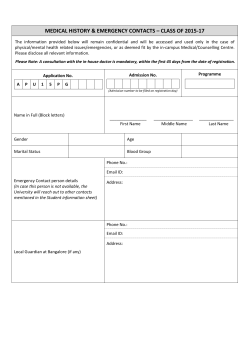
Top Ten Things To Know Treatment of Hypertension in Patients With
Top Ten Things To Know Treatment of Hypertension in Patients With Coronary Artery Disease 1. Increasing blood pressure has been associated with fatal coronary artery disease (CAD) over the range of 115/75 to 185/115 mm Hg for all ages. Each increase in systolic blood pressure (SBP) of 20 mm Hg, or each increase in diastolic blood pressure (DBP) of 10 mm Hg, is estimated to double the risk of a fatal coronary event. 2. For any given SBP, the risk of fatal CAD has been estimated to be 16-fold higher for people 80 to 89 years than for those 40 to 49 years of age. 3. This statement reinforces <140/90 mm Hg as a blood pressure target for secondary prevention of cardiovascular events in patients with CAD and hypertension. 4. The roles of other risk factors are reviewed, but readers are referred to the 2013 ACC/AHA Prevention Guidelines on the assessment of cardiovascular risk, lifestyle, obesity, and blood cholesterol for related strategies addressing cardiovascular risk assessment and management. 5. Pharmacological strategies for patients with hypertension and chronic stable angina may include thiazide or thiazide-like diuretics, β-blockers (particularly after myocardial infarction [MI]), angiotensin converting enzyme (ACE) inhibitors, angiotensin II receptor blockers (ARBs), and calcium channel blockers (CCBs). 6. Specific agents that have been shown to reduce risk in patients with acute coronary syndrome (ACS) include β-blockers, ACE inhibitors or ARBs, and, in certain patients, aldosterone antagonists. Nitrates may also be useful in selected patients. 7. The treatment of hypertension in patients with heart failure (HF) should include a closely monitored exercise program as well as management of risk factors, including obesity, dietary sodium, diabetes mellitus, dyslipidemia, and smoking. 8. For patients with HF with reduced ejection fraction (HFrEF), drugs that have been shown to improve outcomes (e.g., ACE inhibitors or ARBs, β-blockers, aldosterone receptor antagonists) generally also reduce blood pressure and should be used in this population. 9. It is recommended that patients who have hypertension and HF with preserved ejection fraction (HFpEF) receive treatment to control systolic and diastolic hypertension, ventricular rate in the presence of atrial fibrillation, and pulmonary congestion and peripheral edema. The use of β-adrenergic blocking agents, ACE inhibitors, ARBs, or CCBs may reduce symptoms of HF in these patients. 10. The recommendations included in this statement are intended to be appropriate for both blood pressure reduction and the management of CAD on the basis of the currently available evidence. Rosendorff C, et al; on behalf of the American Heart Association, American College of Cardiology, and American Society of Hypertension. Treatment of hypertension in patients with coronary artery disease: a scientific statement from the American Heart Association, American College of Cardiology, and American Society of Hypertension [published online ahead of print March 31, 2015]. Hypertension. doi: 10.1161/HYP.0000000000000018. Rosendorff C, et al; on behalf of the American Heart Association, American College of Cardiology, and American Society of Hypertension. Treatment of hypertension in patients with coronary artery disease: a scientific statement from the American Heart Association, American College of Cardiology, and American Society of Hypertension [published online ahead of print March 31, 2015]. Circulation. doi: 10.1161/CIR.0000000000000207.
© Copyright 2025













